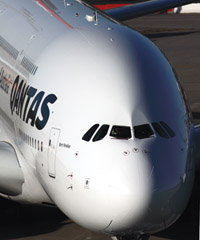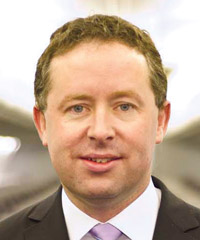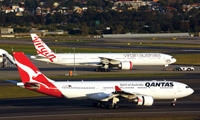Cover Story
RESETTING FOR SURVIVAL
March 1st 2014
DO OR DIE STRATEGY FOR QANTAS
The A$252 million (US$211 million) interim loss reported by Qantas in February was not a near death experience. But it was getting close. And Alan Joyce, the CEO of the Qantas Group, knew it. He has announced a $2 billion rescue package for the airline group, which he hopes will establish sustainable long-term profitability for the company. Is he right? And will the unions and their supporters allow him to see through his plan? Read More »
Alan Joyce (47), had a tough week at the top in February. After he had announced a $2 billion rescue package, planned to restore Qantas to its status as an iconic Australian success story, he faced a barrage of calls from some politicians and unionists to step down. The news that Australia’s prime minister, Tony Abbott, was backing away from any government support must not have helped.
But Joyce, of the lilting accent and easy Irish charm, stood firm. He declared he was in for the long haul and that the Qantas board backed him. But he said he would not step away from the fact that the airline group was in dire straits after it recorded an 2013-2014 interim loss of $252 million, its biggest six-month deficit since privatization in 1993.
The major elements of the $2 billion cost cull to 2017 are a 15% staff reduction (5,000 jobs), an across the board redundancy program, sale or deferral of 50 aircraft, a wage freeze for all employees until the airline is profitable and suspension of expansion at Singapore-based Jetstar Asia. The plan includes deferring delivery of eight A380s and three B787s. Joyce made no mention of the fate of Jetstar Hong Kong, which has yet to be cleared to fly after almost two years in application limbo.
| Australian aviation is hurting Qantas is not alone in its struggle to be profitable. Virgin Australia lost around $49 million in the same period as Qantas reported its $252 million losses. The Virgin Australia red ink does not include potential losses from its 60% equity in in no-frills carrier, Tigerair, which reported a deficit of $16.5 million in the quarter ending December 31. Virgin lost $98.1 million in the 2013 financial year to June. The malaise is not confined to mainstream operators. Regional airline, REX (Regional Express), owned by Singaporean business interests, saw its interim profit plummet by 60%. Chief operating officer, Garry Filmer, said the “entire aviation industry is financially haemorrhaging right now and approaching collapse”. Two regional carriers, Aeropelican and Brindabella Airlines, have closed down in the last year, the latter during the 2013 peak Christmas break. “Many regional carriers have little time left before they face the same fate as Brindabella,” warned Filmer. |
The rescue package Joyce announced followed a results statement with bad news on almost every page. Qantas Domestic profit declined from $194 million in the first half of 2013 to $50.9 million in the latest six months. Qantas International lost $234 million, compared with an $81.3 million loss in the same period last year.
The Jetstar group has turned a profit of $114.4 million into a $14.3 million loss for the latest six months. The only good news was the record profit of $130.4 million at Qantas’ Frequent Flyer sudsidiary.
Joyce said his airline’s performance was “unacceptable” and the situation was “unsustainable”.
 |
In the past five years, Qantas has reduced unit costs by 19%, renewed its fleet with 130 aircraft that reduced its age to an average 7.6 years, consolidated its engineering bases from three to one, modernized numerous maintenance practices, sold non-core assets and instigated a job contraction process.But it was still not enough, said Joyce.
The troubled international arm of Qantas is continuing to deteriorate. In 2003, Qantas held a 32.7% share of international passengers flying in and out of Australia, with Singapore Airlines (SIA) travelers making up another 11.3% of market share and Air New Zealand holding 9.4%. By last year, the Qantas Group’s Australian market share had declined to 25.3%, including Jetstar’s share of 8.1%. SIA’s passenger numbers had declined to 9.1%, just a little ahead of Emirates Airlines with 8.8%. Virgin Australia had 8.1% and Air New Zealand 7.9%.
As a result, Qantas has become the centre of heated exchanges with Virgin Australia as Joyce argues Qantas is disadvantaged because it has to compete with a rival essentially owned by foreign governments through their national airlines. Air New Zealand, Abu Dhabi-based Etihad Airways and Singapore Airlines hold a combined 67% of Virgin, with Virgin Atlantic’s Sir Richard Branson holding another 10%.
Analysts have joined the debate about Qantas management with their objections to Joyce’s determination to maintain a “line in the sand” 65% share of the country’s domestic market, a strategy which has led to overcapacity and plunging yields for airlines.
Joyce blames much of his carrier’s woes on an uneven playing field that he says favours his rivals, especially foreign rivals that have lower labour and other costs and are “often spurred by national economic development goals rather than profit targets and have the backing of their governments to raise capital”, he said.
|
5000
Jobs to disappear by 2017 1500 Jobs lost from management A$252 million Interim loss for fiscal 2013-2014 year A$500 million Redundancy costs paid out in 2014-2015 A$2 billion Company costs removed by 2017 54 Worker enterprise agreements to be negotiated with 14 unions |
“Qantas International capacity has grown by 2.9% since 2009, but competitor capacity into Australia has increased by 46% over the same period,” said Joyce.
“This contrasts with global growth of less than half that rate. In this full financial year alone, international market capacity growth in Australia will be 9%. Domestic capacity has surged, with capacity growth of 18% by the Virgin Group since July 2011, compared with 8% by the Qantas Group. The capacity growth in both our international and domestic markets is led by state-owned airlines.”
High fuel prices and foreign currency movements have exacerbated the problem, costing the group half a billion dollars more in 2013 than in 2009. The fuel bill for 2014 is expected to be a record $4.6 billion, said Joyce.
The Qantas CEO is particularly irked by the almost 70% shareholding held by three big international competitors in Virgin Australia. “Yet Virgin Australia retains all the international traffic rights and benefits of an Australian-designated carrier. In our view, that equates to a majority foreign-owned company getting benefits designed for majority Australian-owned and controlled companies, “ Joyce said.
“Qantas can compete in any fair fight. We have even been able to compete with one hand tied behind our back by the Qantas Sale Act (which limits foreign ownership in Qantas to 49%). But late last year, the three foreign-airline shareholders of Virgin Australia invested more than $300 million into the airline at a time when, as Virgin Australia has since reported to the Australian Stock Exchange, it was losing money.
“That capital injection has facilitated a continuation of capacity growth by Virgin Australia into the Australian domestic market, despite its growing losses.”
As well the stormy debate over possible government assistance for Qantas has acquired new heat in recent weeks. Unlike prime minister Abbott, Australia’s treasurer, Joe Hockey, has flagged the possibility of a lifeline to Qantas via a government debt guarantee. Hockey also would like to scrap the Qantas Sale Act, but he knows, at least for now, the legislation would not be passed into law because the Opposition and the Greens parties want it retained.
In the meantime, the government is drafting legislation to amend the act. It is believed the revision will remove the 25% cap on a single foreign investor in Qantas and the 35% cap for a group of investors.
 |
| 'Qantas’ performance “unacceptable” and “unsustainable”' |
|
Alan Joyce
Qantas Group CEO |
Hockey said guaranteeing Qantas’ debt is the “least worst option” and that the airline is unique and cannot be allowed to fail. Hockey said Qantas has a “ball and chain” around its leg in the form of the Sale Act and faced a “2000 pound gorilla” in Virgin Australia with its foreign ownership.
A debt guarantee would have been similar to the guarantee extended to Australia’s banking sector during the global financial crisis and would establish the Federal Government as an underwriter for Qantas’ debt.
It would lower the cost of future borrowings for the airline and potentially allow the refinancing of existing debt. The “sovereign support” would lower Qantas’ risk factor in the financial markets and potentially help it bounce back from “junk” status.
Virgin Australia chief, John Borghetti, a former Qantas senior executive, isn’t taking any of Joyce’s arguments lying down. He said he would be knocking on the government’s door asking for the same deal within 24 hours if the government provided “cash or financial backing or a guarantee of some description” to Qantas. He accused Qantas of “trying to get a free ride” so it could retain its 65% domestic market share and “knock out” competition in Australian skies.
Borghetti said he supported changes to the Qantas Sale Act which would allow Qantas to accept higher levels of foreign ownership.
“The Qantas Sale Act is outdated. It should be removed and there is no doubt about that,” he said. However, “two wrongs don’t make a right. Just because the Qantas Sale Act is wrong, making another wrong decision by providing a debt guarantee does not make the situation right,” he said.
Virgin Atlantic’s Sir Richard Branson entered into the argument when he published an advertisement in Australian newspapers which said Qantas was “in deep trouble” and if it had been better managed it “would not be in the financial mess it is currently claiming it is in”. The full-page advertisements in Australian Sunday newspapers warned that if the Australian taxpayer was forced to prop up Qantas, business people worldwide should think twice about investing in Australia.
| 'Everyone has noticed the rise of Emirates and Etihad, but we have to start watching the rise of China Southern and the major Chinese airlines. In my view, these major airlines in China will be dominating world aviation alongside Emirates and Etihad within literally three or four years' |
| Warren Truss Australian transport minister |
Qantas’ rivals aren’t the only ones doubting the airline group’s strategy. Analysts and industry insiders are questioning many of its decisions, including the 65% line in the sand Joyce has marked down for domestic market share, as well as its alliance with Emirates Airlines. “Almost everything Qantas is doing is moronic,” says former long-time Qantas executive and now a senior advisor to consultancy L.E.K., Ron Rosalky; not mincing words at all.
“I mean this 65% domestic line in the sand business… all they are doing is costing themselves money. All they say is every time Virgin Australia puts on a domestic flight we’ll put on two. The capacity peak really destroyed the yield and the profit of those airlines. Borghetti would say there’s another side to this. It’s called revenue upside. Qantas seems to be ignoring this.”
And Andrew Drysdale, former chief executive of Fiji’s Air Pacific (before it was renamed Fiji Airways) and a former Asia-Pacific director of the International Air Transport Association (IATA) said: “You can nail that flag to the mast if you like. We’ll watch it sink. It’s a nonsense.
“Obviously, they need to have powerful domestic penetration, but to set an artificial line like that is nearly as bad as the curfew and the capacity cap at Sydney airport.”
| Qantas’ A$2 billion cost cull A 15% reduction in Qantas’s 33,000 staff will apply to management, maintenance staff and flying crew. A wage freeze will be imposed across the Qantas group and remain in place until the group returns to profit. The present wage and bonus freeze for senior executive will continue. After a review of networks and schedules, Qantas will terminate under-performing routes, re-assign aircraft to better match demand and increase utilization through improved turnaround times. Deferral in delivery of eight A380s and three B787s. The retirement of 15 B767s will be brought forward to 2015. Six older B747s will exit the fleet by early 2016 and all B737-400s will depart the carrier this month. Qantas’ fleet will be reduced from 11 aircraft types to seven by the end of June in 2016. Expansion at Singapore-based Jetstar Asia, is put on hold until operating conditions improve. Operating emphasis will be on establishing sustainable profits of existing businesses and partnerships. Jetstar Hong Kong is still awaiting clearance to fly. Restructuring of catering operations, including the closure of its catering unit in Adelaide. Closure of the Avalon maintenance base, outside Melbourne, which had been announced. |
Another former senior Qantas executive who asked not to be identified suggested there was a “little bit of cry wolf” about the airline’s situation, pointing out it still has $3.5 billion in the bank. He believed strongly that if Qantas was given a sovereign guarantee it has to be given to all airlines, including Virgin Australia.
Orient Aviation spoke to a number of ex-Qantas managers and they were unanimous in their view that a large part of the airline’s problems have arisen from the alliance deal with Emirates Airlines. “It’s a terrible deal, it’s killing them and everybody knows it is,” said one.
“Not only is it a terrible deal in the sense of it not producing any monetary benefits for Qantas, it has hurt them in the market in Asia.” This is because big Asian carriers such as Singapore Airlines and Cathay Pacific Airways regard the deal as Qantas opening the door to the big Gulf carrier. They have responded by putting more of their own capacity into the market.
At the same time, Qantas has lost out on profitable routes, such as Melbourne to London through Singapore, where it filled services to Europe with Melbourne traffic, connecting passengers from Brisbane and Perth and Singaporeans. “Now, it goes to Dubai and there are no (Qantas) flights from Perth and Brisbane and there is very little pick-up from Dubai.
 |
“If you want to go on to Europe or anywhere else in Britain except for London, you may as well go with Emirates,” said one ex-Qantas manager. Sources told Orient Aviation that in an effort to retrieve the situation, Qantas officials have been in Europe trying to revive co-operative deals with Air France and British Airways, which were ended when the Emirates alliance was forged.
Meanwhile, Joyce continues to highlight that since being privatized Qantas has succeeded without the benefits many of its competitors receive from public funds. “No preferred access to airports, no tax breaks, no free infrastructure, no public subsidy. We have never asked for a handout and we are not asking for one now,” he said.
“Over the past five years, we have done everything in our control to reform Qantas for the changing global economy. But when one set of rules applies to Qantas and another to our competitors, then a clear distortion exists.
“The Qantas Sale Act limits our financial options, it adds cost to our business. It influences our actions as a publicly listed company. Over the long term, repealing it is essential to remove the distortions in our aviation system.”
“There are many examples of Australian companies that have failed because they have not been prepared to make the hard decisions but Qantas isn’t one of them,” he declared. “Our 93- year history Qantas has a record of resilience and adaptation. We’ve survived through war and crisis, boom and bust. Over the last five years we’ve shown yet again that we can take the necessary decisions to adapt to a changing world.
“We are now enduring some of the toughest conditions we’ve ever faced. So we are doing what is right and necessary. At the end of this transformation the Qantas Group will still be an employer of more than 27,000 people, the vast majority based in Australia.”